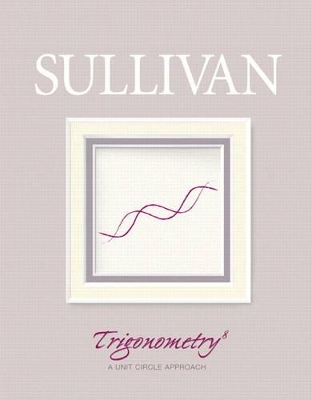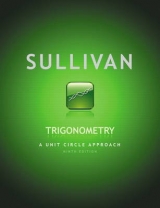
Trigonometry
Pearson
978-0-13-239279-2 (ISBN)
- Titel erscheint in neuer Auflage
- Artikel merken
The Eighth Edition of this dependable text retains its best features-accuracy, precision, depth, strong student support, and abundant exercises, while substantially updating content and pedagogy. After completing the book, students will be prepared to handle the algebra found in subsequent courses such as finite mathematics, business mathematics, and engineering calculus.
Mike Sullivan Professor of Mathematics at Chicago State University received a Ph.D. in mathematics from Illinois Institute of Technology. Mike has taught at Chicago State for over 35 years. He has been writing textbooks in mathematics for over 30 years. Mike has authored or co-authored over ten books. He is a native of Chicago’s South Side and currently resides in Oaklawn. He has four children: Kathleen, who teaches college mathematics, Mike III, who co-authors many titles as well as teaches college mathematics, Dan, who is a Prentice Hall sales representative, and Colleen, who teaches middle-school mathematics. Nine grandchildren round out the family. Why I Wrote This Book: As a professor of mathematics at an urban public university for over 35 years, I understand the varied needs of precalculus students who range from having little mathematical background and a fear of mathematics courses to those who have had a strong mathematical education and are highly motivated. For some of your students, this will be their last course in mathematics, while others may decide to further their mathematical education. I have written this text for both groups. As the author of precalculus, engineering calculus, finite math and business calculus texts, and, as a teacher, I understand what students must know if they are to be focused and successful in upper level mathematics courses. However, as a father of four, I also understand the realities of college life. I have taken great pains to insure that this text contains solid, student-friendly examples and problems, as well as a clear writing style. I encourage you to share with me your experiences teaching from this text. The eighth edition of this series builds upon a solid foundation by integrating new features and techniques that further enhance student interest and involvement. The elements of the previous edition that have proved successful remain, while many changes, some obvious, others subtle, have been made. A huge benefit of authoring a successful series is the broad-based feedback upon which improvements and additions are ultimately based. Virtually every change to this edition is the result of thoughtful comments and suggestions made from colleagues and students who have used the previous edition. I am sincerely grateful for this feedback and have tried to make changes that improve the flow and usability of this text.
TABLE OF CONTENTS
Chapter 1 Graphs and Functions 1.1 The Distance and Midpoint Formulas
1.2 Graphs of Equations; Circles
1.3 Functions and Their Graph
1.4 Properties of Functions
1.5 Library of Functions; Piecewise-defined Functions
1.6 Graphing Techniques: Transformations
1.7 One-to-One Functions; Inverse Functions
Chapter Review
Chapter Test
Cumulative Review
Chapter Projects
Chapter 2 Trigonometric Functions
2.1 Angles and Their Measure
2.2 Trigonometric Functions: Unit Circle Approach
2.3 Properties of the Trigonometric Functions
2.4 Graphs of the Sine and Cosine Functions
2.5 Graphs of the Tangent, Cotangent, Cosecant, and Secant Functions
2.6 Phase Shift; Sinusoidal Curve Fitting
Chapter Review
Chapter Test
Cumulative Review
Chapter Projects
Chapter 3 Analytic Trigonometry
3.1 The Inverse Sine, Cosine, and Tangent Functions
3.2 The Inverse Trigonometric Functions (continued)
3.3 Trigonometric Identities
3.4 Sum and Difference Formulas
3.5 Double-Angle and Half-Angle Formulas
3.6 Product-to-Sum and Sum-to-Product Formulas
3.7 Trigonometric Equations (I)
3.8 Trigonometric Equations (II)
Chapter Review
Chapter Test
Cumulative Review
Chapter Projects
Chapter 4 Applications of Trigonometric Functions
4.1 Applications Involving Right Triangles
4.2 Law of Sines
4.3 Law of Cosines
4.4 Area of a Triangle
4.5 Simple Harmonic Motion; Damped Motion; Combining Waves
Chapter Review
Chapter Test
Cumulative Review
Chapter Projects
Chapter 5 Polar Coordinates; Vectors
5.1 Polar Coordinates
5.2 Polar Equations and Graphs
5.3 The Complex Plane; DeMoivre’s Theorem
5.4 Vectors
5.5 The Dot Product
5.6 Vectors in Space
5.7 The Cross Product
Chapter Review
Chapter Test
Cumulative Review
Chapter Projects
Chapter 6 Analytic Geometry
6.1 Conics
6.2 The Parabola
6.3 The Ellipse
6.4 The Hyperbola
6.5 Rotation of Axes; General Form of a Conic
6.6 Polar Equations of Conics
6.7 Plane Curves and Parametric Equations
Chapter Review
Chapter Test
Cumulative Review
Chapter Projects
Chapter 7 Exponential and Logarithmic Functions
7.1 Exponential Functions
7.2Logarithmic Functions
7.3 Properties of Logarithms
7.4 Logarithmic and Exponential Equations
7.5 Compound Interest
7.6 Exponential Growth and Decay Models; Newton’s Law; Logistic Growth and Decay Models
7.7 Building Exponential, Logarithmic, and Logistic Functions from Data
Chapter Review
Chapter Test
Cumulative Review
Chapter Projects
Appendix A Review
A.1 Algebra Essentials
A.2 Geometry Essentials
A.3 Factoring Polynomials
A.4 Solving Equations
A.5 Complex Numbers; Quadratic Equations in the Complex Number System
A.6 Interval Notation; Solving Inequalities
A.7 nth Roots; Rational Exponents; Radical Equations
A.8 Lines
A.9 Building Linear Functions from Data
Appendix B Graphing Utilities
B.1 The Viewing Rectangle
B.2 Using a Graphing Utility to Graph Equations
B.3 Using a Graphing Utility to Locate Intercepts and Check for Symmetry
B.4 Using a Graphing Utility to Solve Equations
B.5 Square Screens
| Erscheint lt. Verlag | 7.6.2007 |
|---|---|
| Sprache | englisch |
| Maße | 288 x 221 mm |
| Gewicht | 1782 g |
| Themenwelt | Mathematik / Informatik ► Mathematik ► Geometrie / Topologie |
| ISBN-10 | 0-13-239279-8 / 0132392798 |
| ISBN-13 | 978-0-13-239279-2 / 9780132392792 |
| Zustand | Neuware |
| Haben Sie eine Frage zum Produkt? |
